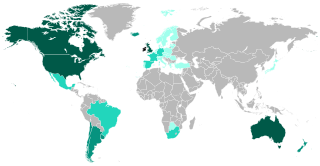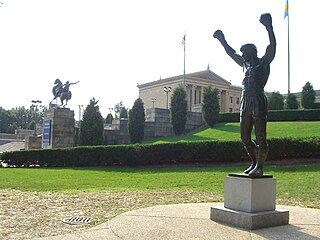
The Irish diaspora refers to ethnic Irish people and their descendants who live outside the island of Ireland.

South Bend is a city in and the county seat of St. Joseph County, Indiana, United States, on the St. Joseph River near its southernmost bend, from which it derives its name. At the 2020 census, the city had a total of 103,453 residents and is the fourth-largest city in Indiana. Located just south of the border with Michigan, South Bend anchors the Michiana region and is 72 miles (116 km) east of downtown Chicago. The metropolitan area had a population of 324,501 in 2020, while its combined statistical area had 812,199.

German Americans are Americans who have full or partial German ancestry.

Polish Americans are Americans who either have total or partial Polish ancestry, or are citizens of the Republic of Poland. There are an estimated 8.81 million self-identified Polish Americans, representing about 2.67% of the U.S. population, according to the 2021 American Community Survey conducted by the U.S. Census Bureau.

Irish Canadians are Canadian citizens who have full or partial Irish heritage including descendants who trace their ancestry to immigrants who originated in Ireland. 1.2 million Irish immigrants arrived from 1825 to 1970, and at least half of those in the period from 1831 to 1850. By 1867, they were the second largest ethnic group, and comprised 24% of Canada's population. The 1931 national census counted 1,230,000 Canadians of Irish descent, half of whom lived in Ontario. About one-third were Catholic in 1931 and two-thirds Protestant.
Cape Verdean Americans are an ethnic group of Americans whose ancestors were Cape Verdean. In 2010, the American Community Survey stated that there were 95,003 Americans living in the US with Cape Verdean ancestors.
Irish-Scots are people in Scotland who have Irish ancestry. Although there has been migration from Ireland to Scotland and elsewhere in Britain for millennia, Irish migration to Scotland increased in the nineteenth century, and was highest following the Great Famine and played a major role, even before Catholic Emancipation in 1829, in rebuilding and re-establishing the formerly illegal Catholic Church in Scotland following centuries of religious persecution. In this period, the Irish typically settled in urban slum neighborhoods and around industrial areas. Irish ancestry is by far the most common foreign ancestry in Scotland.

The Irish community is one of New York City's major and important ethnic groups, and has been a significant proportion of the city's population since the waves of immigration in the late 19th century.

At the 2010 census, there were 1,526,006 people, 590,071 households, and 352,272 families residing in the consolidated city-county of Philadelphia, Pennsylvania. The population density was 4,337.3 people/km2. There were 661,958 housing units at an average density of 1,891.9 units/km2.
Belgian Americans are Americans who can trace their ancestry to people from Belgium who immigrated to the United States. While the first natives of the then-Southern Netherlands arrived in America in the 17th century, the majority of Belgian immigrants arrived during the 19th and 20th centuries.

The culture of Philadelphia goes back to 1682 when Philadelphia was established by William Penn, founder of the colonial-era Province of Pennsylvania. Philadelphia emerged quickly as the largest and most influential city in the Thirteen Colonies.

Americanization is the process of an immigrant to the United States becoming a person who shares American culture, values, beliefs, and customs by assimilating into the American nation. This process typically involves learning the American English language and adjusting to American culture, values, and customs. It can be considered another form of, or an American subset of Anglicization.

The history of immigration to the United States details the movement of people to the United States from the colonial era to the present day. Throughout U.S. history, the country experienced successive waves of immigration, particularly from Europe and later on from Asia and Latin America. Colonial-era immigrants often repaid the cost of transoceanic transportation by becoming indentured servants in which the new employer paid the ship's captain. In the late 19th century, immigration from China and Japan was restricted. In the 1920s, restrictive immigration quotas were imposed but political refugees had special status. Numerical restrictions ended in 1965. In recent years, the largest numbers of immigrants to the United States have come from Asia and Central America.
Those of Irish ancestry have had a strong impact on the city of Indianapolis, Indiana. In total, they are the second largest ethnic group in Indianapolis.
Nativism is the political policy of promoting or protecting the interests of native-born or indigenous people over those of immigrants, including the support of anti-immigration and immigration-restriction measures. In the United States, nativism does not refer to a movement led by Native Americans, also referred to as American Indians.

Non-Hispanic Whites or Non-Latino Whites are White Americans classified by the United States census as "white" and not Hispanic. According to the United States Census Bureau yearly estimates, as of July 1, 2023, Non-Hispanic whites make up about 58.4% of the U.S. population. The United States Census Bureau defines white to include European Americans, Middle Eastern Americans, and North African Americans. Americans of European ancestry are divided into various ethnic groups. More than half of the white population are German, Irish, English, French and Polish Americans. Many Americans are also the product of other European groups that migrated to parts of the US in the 19th and 20th centuries, as the bulk of immigrants from various countries in Northern, Central, Eastern, and Southeastern Europe, as well as the Caucasus region, migrated to the United States.

There have been a variety of ethnic groups in Baltimore, Maryland and its surrounding area for 12,000 years. Prior to European colonization, various Native American nations have lived in the Baltimore area for nearly 3 millennia, with the earliest known Native inhabitants dating to the 10th millennium BCE. Following Baltimore's foundation as a subdivision of the Province of Maryland by British colonial authorities in 1661, the city became home to numerous European settlers and immigrants and their African slaves. Since the first English settlers arrived, substantial immigration from all over Europe, the presence of a deeply rooted community of free black people that was the largest in the pre-Civil War United States, out-migration of African-Americans from the Deep South, out-migration of White Southerners from Appalachia, out-migration of Native Americans from the Southeast such as the Lumbee and the Cherokee, and new waves of more recent immigrants from Latin America, the Caribbean, Asia and Africa have added layers of complexity to the workforce and culture of Baltimore, as well as the religious and ethnic fabric of the city. Baltimore's culture has been described as "the blending of Southern culture and [African-American] migration, Northern industry, and the influx of European immigrants—first mixing at the port and its neighborhoods...Baltimore’s character, it’s uniqueness, the dialect, all of it, is a kind of amalgamation of these very different things coming together—with a little Appalachia thrown in...It’s all threaded through these neighborhoods", according to the American studies academic Mary Rizzo.

Mexican Americans have lived in Los Angeles since the original Pobladores, the 44 original settlers and 4 soldiers who founded the city in 1781. People of Mexican descent make up 31.9% of Los Angeles residents, and 32% of Los Angeles County residents.

Irish Americans are ethnic Irish who live in the United States and are American citizens. Most Irish Americans of the 21st century are descendants of immigrants who moved to the United States in the mid-19th century because of the Great Famine in Ireland.
The term Irish New Zealander refers to New Zealanders of full or partial Irish ancestry. This includes Irish immigrants as well as New Zealanders of Irish descent. The term makes no distinction concerning religion and encompasses both Catholic and Protestant immigrants and their descendants; nonetheless, the chief criterion of distinction between Irish immigrants, especially those who arrived in the nineteenth century, is religion.














